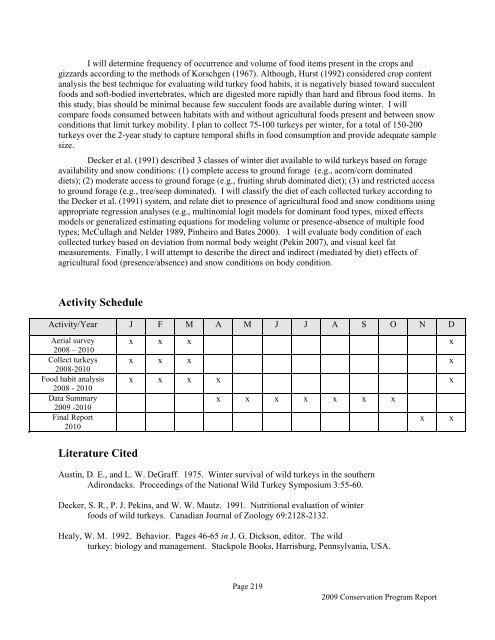camp ripley and arden hills minnesota army national guard training ...
camp ripley and arden hills minnesota army national guard training ...
camp ripley and arden hills minnesota army national guard training ...
You also want an ePaper? Increase the reach of your titles
YUMPU automatically turns print PDFs into web optimized ePapers that Google loves.
I will determine frequency of occurrence <strong>and</strong> volume of food items present in the crops <strong>and</strong><br />
gizzards according to the methods of Korschgen (1967). Although, Hurst (1992) considered crop content<br />
analysis the best technique for evaluating wild turkey food habits, it is negatively biased toward succulent<br />
foods <strong>and</strong> soft-bodied invertebrates, which are digested more rapidly than hard <strong>and</strong> fibrous food items. In<br />
this study, bias should be minimal because few succulent foods are available during winter. I will<br />
compare foods consumed between habitats with <strong>and</strong> without agricultural foods present <strong>and</strong> between snow<br />
conditions that limit turkey mobility. I plan to collect 75-100 turkeys per winter, for a total of 150-200<br />
turkeys over the 2-year study to capture temporal shifts in food consumption <strong>and</strong> provide adequate sample<br />
size.<br />
Decker et al. (1991) described 3 classes of winter diet available to wild turkeys based on forage<br />
availability <strong>and</strong> snow conditions: (1) complete access to ground forage (e.g., acorn/corn dominated<br />
diets); (2) moderate access to ground forage (e.g., fruiting shrub dominated diet); (3) <strong>and</strong> restricted access<br />
to ground forage (e.g., tree/seep dominated). I will classify the diet of each collected turkey according to<br />
the Decker et al. (1991) system, <strong>and</strong> relate diet to presence of agricultural food <strong>and</strong> snow conditions using<br />
appropriate regression analyses (e.g., multinomial logit models for dominant food types, mixed effects<br />
models or generalized estimating equations for modeling volume or presence-absence of multiple food<br />
types; McCullagh <strong>and</strong> Nelder 1989, Pinheiro <strong>and</strong> Bates 2000). I will evaluate body condition of each<br />
collected turkey based on deviation from normal body weight (Pekin 2007), <strong>and</strong> visual keel fat<br />
measurements. Finally, I will attempt to describe the direct <strong>and</strong> indirect (mediated by diet) effects of<br />
agricultural food (presence/absence) <strong>and</strong> snow conditions on body condition.<br />
Activity Schedule<br />
Activity/Year J F M A M J J A S O N D<br />
Aerial survey<br />
2008 – 2010<br />
Collect turkeys<br />
2008-2010<br />
Food habit analysis<br />
2008 - 2010<br />
Data Summary<br />
2009 -2010<br />
Final Report<br />
2010<br />
Literature Cited<br />
x x x x<br />
x x x x<br />
x x x x x<br />
x x x x x x x<br />
Austin, D. E., <strong>and</strong> L. W. DeGraff. 1975. Winter survival of wild turkeys in the southern<br />
Adirondacks. Proceedings of the National Wild Turkey Symposium 3:55-60.<br />
Decker, S. R., P. J. Pekins, <strong>and</strong> W. W. Mautz. 1991. Nutritional evaluation of winter<br />
foods of wild turkeys. Canadian Journal of Zoology 69:2128-2132.<br />
Healy, W. M. 1992. Behavior. Pages 46-65 in J. G. Dickson, editor. The wild<br />
turkey: biology <strong>and</strong> management. Stackpole Books, Harrisburg, Pennsylvania, USA.<br />
Page 219<br />
2009 Conservation Program Report<br />
x x
















